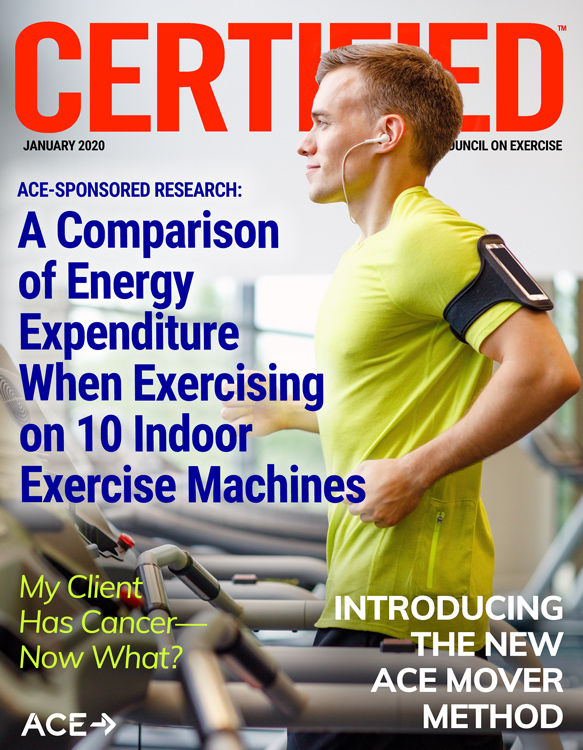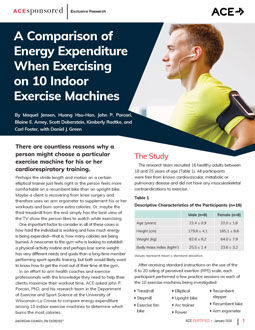
By Maquel Jensen, Huang Hsu-Han, John P. Porcari, Blaine E. Arney, Scott Doberstein, Kimberly Radtke, and Carl Foster, with Daniel J. Green
There are countless reasons why a person might choose a particular exercise machine for his or her cardiorespiratory training. Perhaps the stride length and motion on a certain elliptical trainer just feels right or the person feels more comfortable on a recumbent bike than an upright bike. Maybe a client is recovering from knee surgery and therefore uses an arm ergometer to supplement his or her workouts and burn some extra calories. Or, maybe the third treadmill from the end simply has the best view of the TV show the person likes to watch while exercising.
One important factor to consider in all of these cases is how hard the individual is working and how much energy is being expended—that is, how many calories are being burned. A newcomer to the gym who is looking to establish a physical-activity routine and perhaps lose some weight has very different needs and goals than a long-time member performing sport-specific training, but both would likely want to know how to get the most out of their time at the gym.
In an effort to arm health coaches and exercise professionals with the knowledge they need to help their clients maximize their workout time, ACE asked John P. Porcari, PhD, and his research team in the Department of Exercise and Sport Science at the University of Wisconsin–La Crosse to compare energy expenditure among 10 indoor exercise machines to determine which burns the most calories.
The Study
The research team recruited 16 healthy adults between 18 and 25 years of age (Table 1). All participants were free from known cardiovascular, metabolic or pulmonary disease and did not have any musculoskeletal contraindications to exercise.
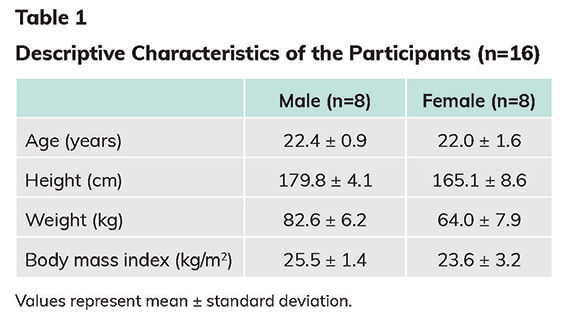
After receiving standard instructions on the use of the 6 to 20 rating of perceived exertion (RPE) scale, each participant performed a few practice sessions on each of the 10 exercise machines being investigated:
- Treadmill
- Stepmill
- Exercise fan bike
- Elliptical
- Upright bike
- Arc trainer
- Rower
- Recumbent stepper
- Recumbent bike
- Arm ergometer
During the practice sessions, which included the use of two machines during each session, the participants exercised at intensities equal to RPEs of 11 (“light”), 13 (“somewhat hard”) and 15 (“hard”) for approximately five minutes each.
The five study sessions mirrored these practice sessions, with participants exercising on two machines (in random order) with a minimum of 48 hours between sessions. On each machine, participants warmed up for three minutes, performed five-minute exercise bouts at RPE intensity levels of 11, 13 and 15, in that order and with no break between RPE levels, and then cooled down for three minutes. The participants then rested for 15 minutes and repeated this routine on a second machine.
Heart rate (HR) was recorded at the end of each minute, RPE was assessed at the end of each stage and oxygen consumption (VO2) was continuously measured throughout the session. Energy expenditure was calculated from the VO2 data.
The Results
Heart Rate
The HR responses when exercising on each of the 10 machines at each RPE level are presented in Table 2 and Figure 1.
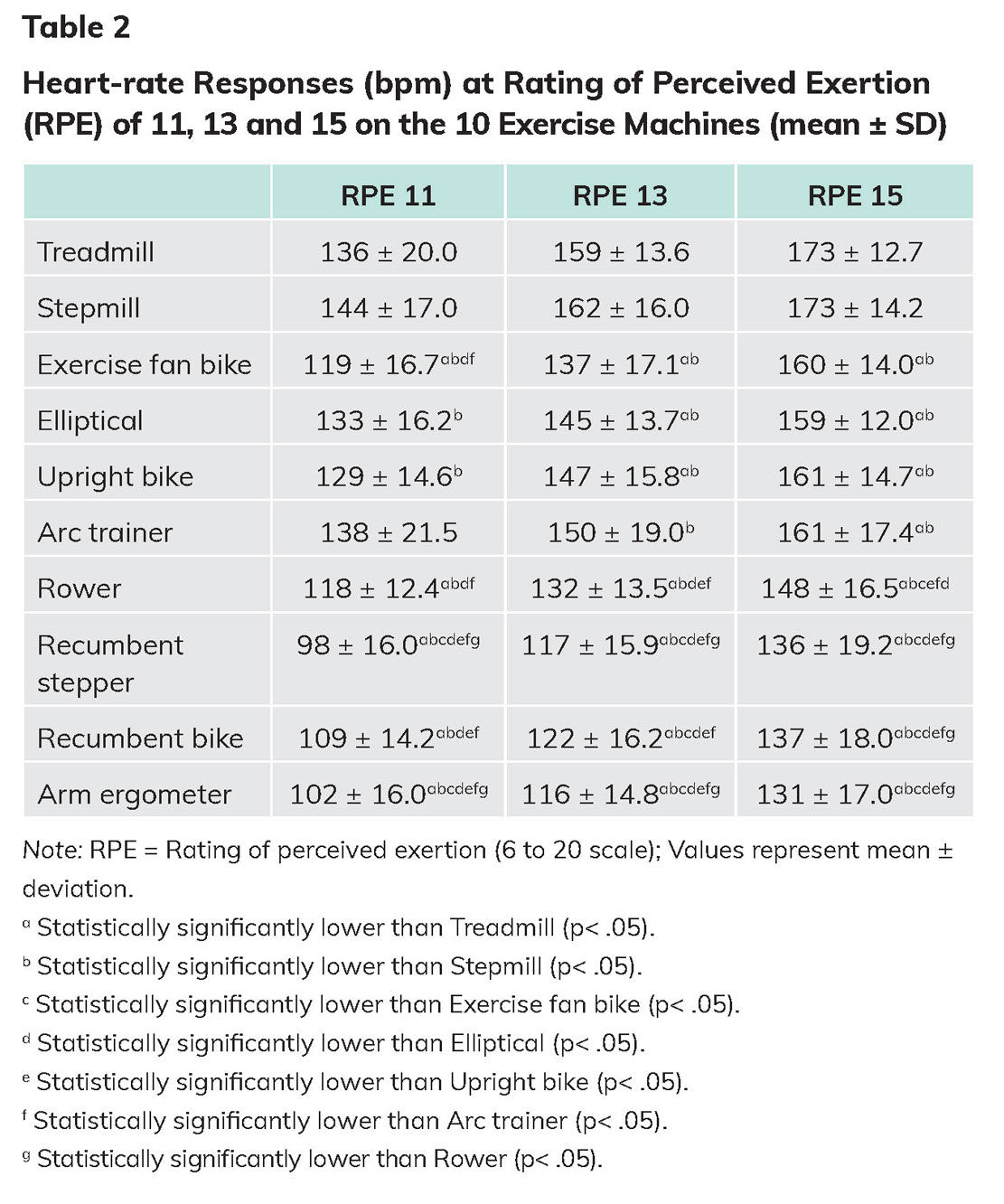
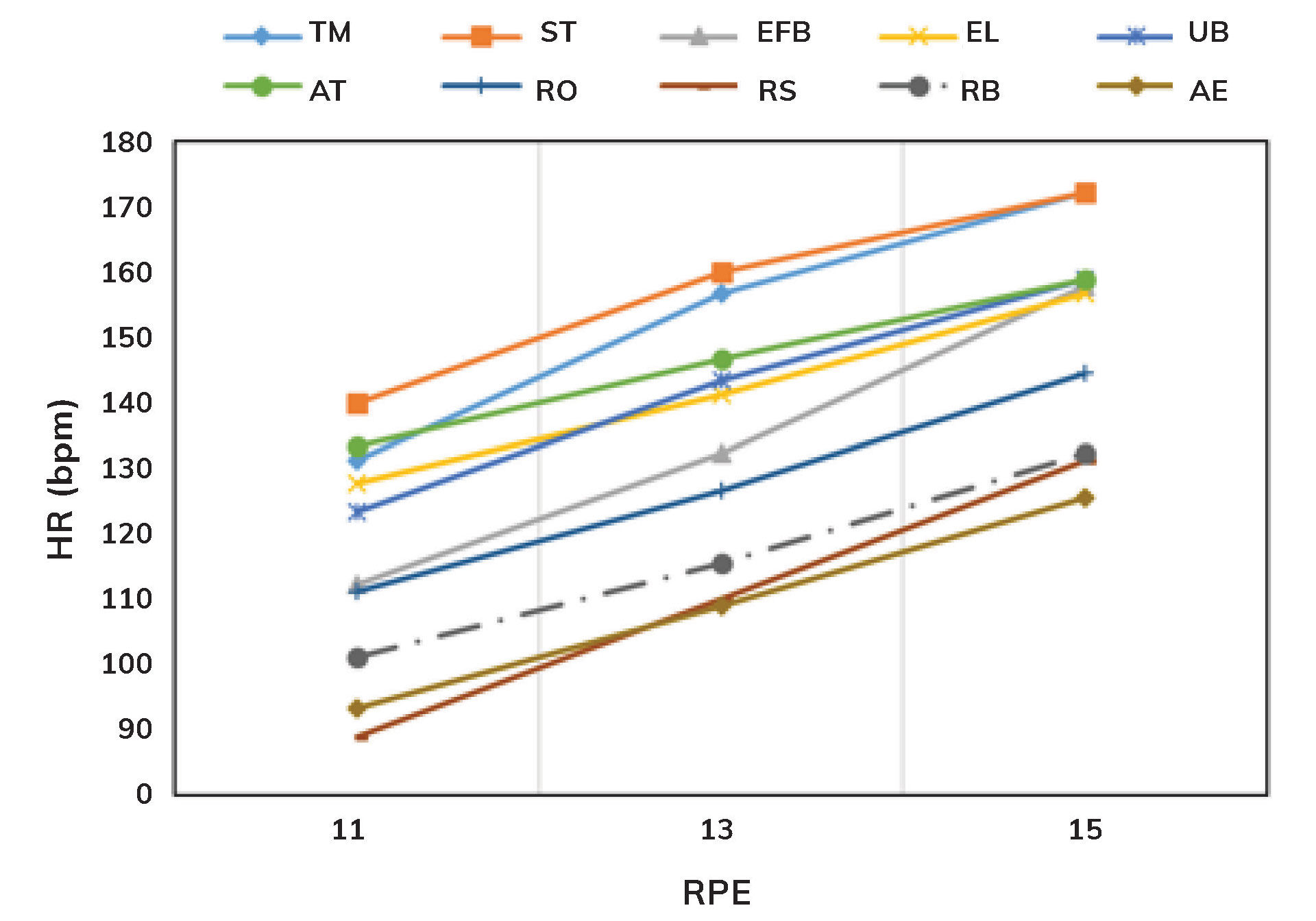
Figure 1. Heart rate (HR) (bpm) on the 10 exercise machines at rating of perceived exertion (RPE) levels of 11, 13 and 15
Note: TM = Treadmill; ST = Stepmill; EFB = Exercise fan bike; EL = Elliptical; UB = Upright bike; AT = Arc trainer; RO = Rower; RS = Recumbent stepper; RB = Recumbent bike; AE = Arm ergometer
As you can see, there were statistically significant differences in HR between machines, with values varying by up to 46 beats per minute (bpm) at a given RPE. Generally speaking, the treadmill and stepmill elicited the highest HR at each RPE level. This was followed by the elliptical, arc trainer, upright bike, rower and exercise fan bike. The recumbent stepper, recumbent bike and arm ergometer yielded the lowest HR responses.
Energy Expenditure
The energy expenditure data at each RPE level are presented in Table 3 and Figure 2. Remember, energy expenditure was calculated from the VO2 data.
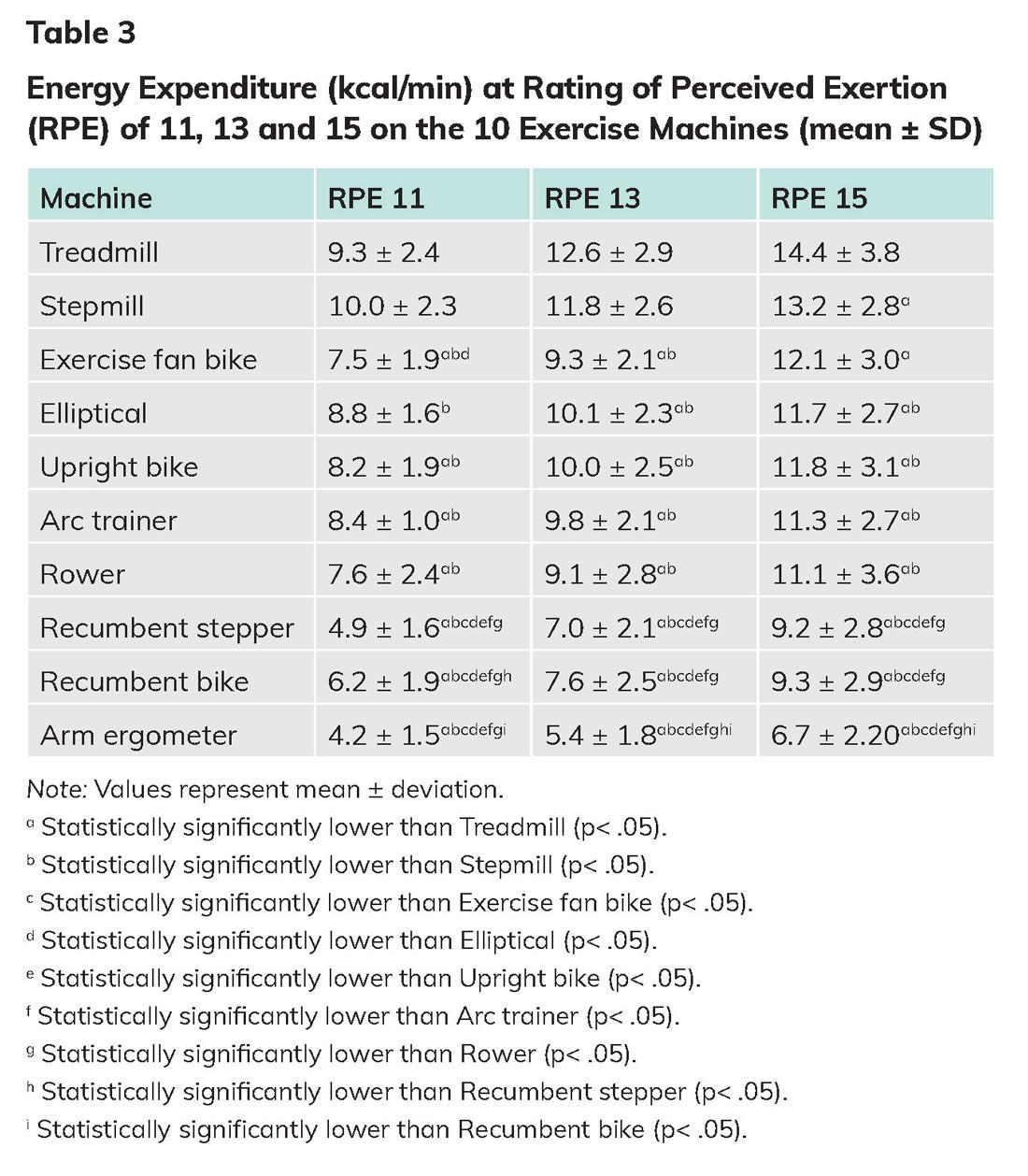
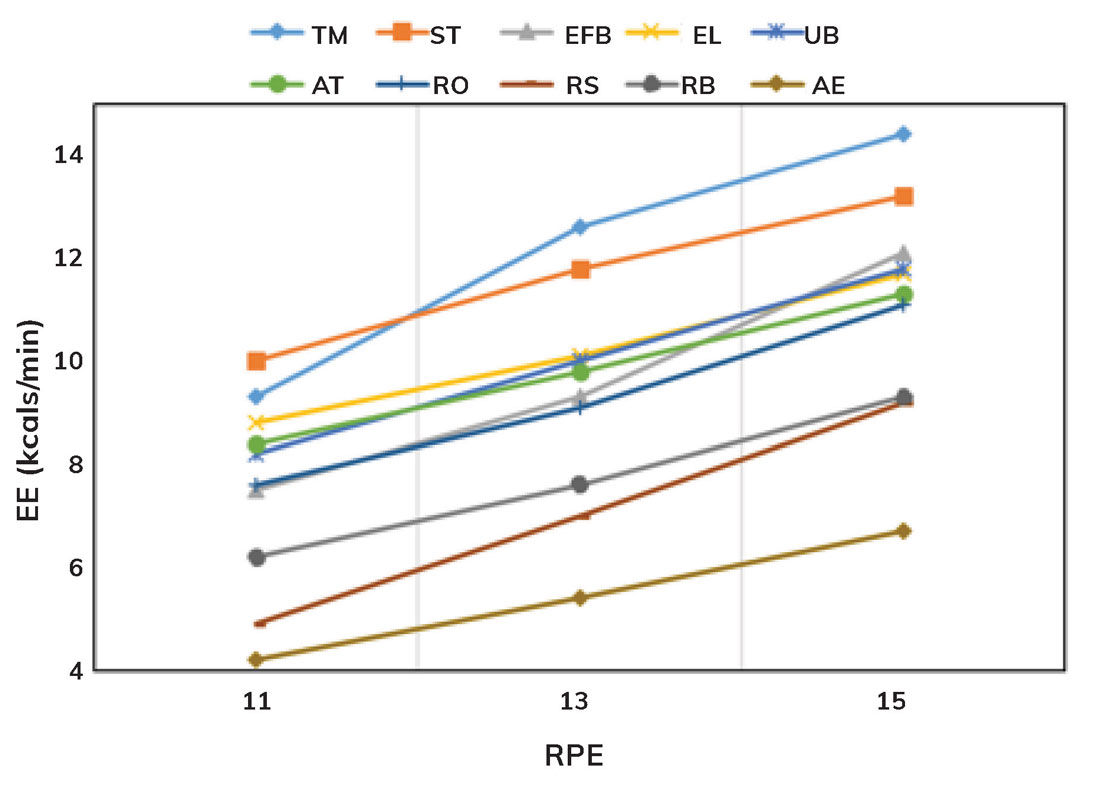
Figure 2. Energy expenditure (EE) (kcals/min) on the 10 exercise machines at rating of perceived exertion (RPE) levels of 11, 13 and 15
Note: TM = Treadmill; ST = Stepmill; EFB = Exercise fan bike; EL = Elliptical; UB = Upright bike; AT = Arc trainer; RO = Rower; RS = Recumbent stepper; RB = Recumbent bike; AE = Arm ergometer
While there were variances in energy expenditure among the machines, the data generally fell into four distinct groupings. Energy expenditure for each machine, collapsed across all three RPE levels, is presented in Figure 3. The treadmill and stepmill elicited statistically significant higher energy expenditures compared to all other modalities.
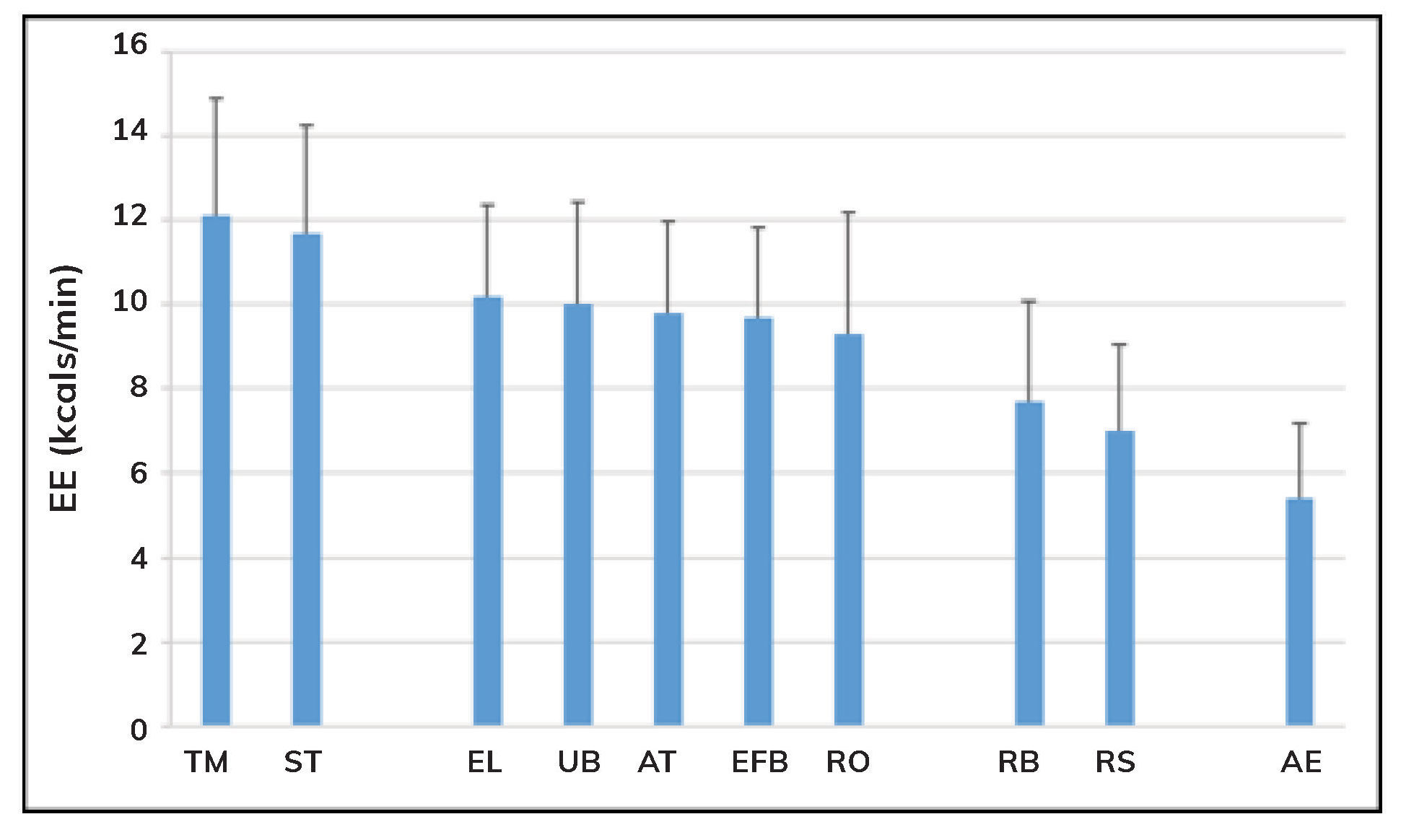
Figure 3. Energy expenditure (EE) (kcal/min) on the 10 exercise machines averaged across rating of perceived exertion (RPE) levels
Note: TM = Treadmill; ST = Stepmill; EFB = Exercise fan bike; EL = Elliptical; UB = Upright bike; AT = Arc trainer; RO = Rower; RS = Recumbent stepper; RB = Recumbent bike; AE = Arm ergometer
Finally, the energy expenditure resulting from 30 minutes of exercise on each machine and how long it would take to burn 300 calories is presented in Table 4. This table was developed based on the energy expenditure at an RPE of 13 (“somewhat hard”) and again illustrates the considerable variability in energy expenditure on the 10 machines tested.

The Bottom Line
The primary purpose of this study was to compare energy expenditure on 10 indoor exercise machines and identify which one burns the most calories during exercise. As you can see in Figure 3, the machines fell into four distinct tiers, with the treadmill and stepmill leading the pack, and the recumbent bike and recumbent stepper ranked lowest among the lower-body machines.
The arm ergometer burned the fewest calories of the 10 machines, which is not surprising considering that it uses smaller muscles to perform the work than any of the other machines tested.
Dr. Porcari explains why the two recumbent machines burned fewer calories than the other lower-body machines: “The recumbent position facilitates venous return because the blood is flowing horizontally back to the heart, which means the stroke volume will be higher and heart rate will be lower.” In other words, fewer heart beats are needed to move the same amount of blood. “In contrast,” Porcari continues, “upright, weight-bearing exercise on the treadmill and stepmill requires the blood to flow upward against gravity. This lowered venous return and stroke volume increase the heart rate, and therefore calorie burn.”
Of course, calorie burn is only one of many things to consider when selecting an exercise machine. Exercise experience, fitness level, injury history and comfort level must be considered as well. In addition, many clients participate in cross-training to add variety to their programs, so they may be exercising on more than one machine on a regular basis.
As Dr. Porcari states, “No machine is bad.” There are potential benefits to every exercise machine tested. For example, jogging on a treadmill does not involve any upper-body musculature, so if a client’s goal is to get a total-body workout, the exercise fan bike or a rowing machine might be better options. If a client has lower-body orthopedic concerns, he or she might benefit from using the recumbent stepper, upright bike, recumbent bike or elliptical, as these machines have lower impact forces than using the treadmill.
Clearly, there is a lot to consider, but health coaches and exercise professionals can use the results of this study to inform their programming and guide clients to make the most of their workouts. The best exercise is the one that a client will perform regularly. The fact that the treadmill burns the most calories is meaningless to clients who are not fit enough for weight-bearing exercise, are recovering from a knee injury or simply don’t enjoy walking on the treadmill.
The decision about which machine a client uses should be as personalized as the rest of his or her exercise programming—but may be informed by the type of evidence this study provides.





 by
by 